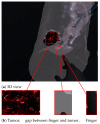Tumor Lung Visualization and Localization through Virtual Reality and Thermal Feedback Interface
- PMID: 36766672
- PMCID: PMC9914223
- DOI: 10.3390/diagnostics13030567
Tumor Lung Visualization and Localization through Virtual Reality and Thermal Feedback Interface
Abstract
The World Health Organization estimates that there were around 10 million deaths due to cancer in 2020, and lung cancer was the most common type of cancer, with over 2.2 million new cases and 1.8 million deaths. While there have been advances in the diagnosis and prediction of lung cancer, there is still a need for new, intelligent methods or diagnostic tools to help medical professionals detect the disease. Since it is currently unable to detect at an early stage, speedy detection and identification are crucial because they can increase a patient's chances of survival. This article focuses on developing a new tool for diagnosing lung tumors and providing thermal touch feedback using virtual reality visualization and thermal technology. This tool is intended to help identify and locate tumors and measure the size and temperature of the tumor surface. The tool uses data from CT scans to create a virtual reality visualization of the lung tissue and includes a thermal display incorporated into a haptic device. The tool is also tested by touching virtual tumors in a virtual reality application. On the other hand, thermal feedback could be used as a sensory substitute or adjunct for visual or tactile feedback. The experimental results are evaluated with the performance comparison of different algorithms and demonstrate that the proposed thermal model is effective. The results also show that the tool can estimate the characteristics of tumors accurately and that it has the potential to be used in a virtual reality application to "touch" virtual tumors. In other words, the results support the use of the tool for diagnosing lung tumors and providing thermal touch feedback using virtual reality visualization, force, and thermal technology.
Keywords: thermal model; thermal sensation; tumor localization; virtual reality (VR).
Conflict of interest statement
The authors declare no conflict of interest.
Figures








References
-
- Uzelaltinbulat S., Ugur B. Lung tumor segmentation algorithm. Procedia Comput. Sci. 2017;120:140–147. doi: 10.1016/j.procs.2017.11.221. - DOI
-
- Marino M.A., Leithner D., Sung J., Avendano D., Morris E.A., Pinker K., Jochelson M.S. Radiomics for tumor characterization in breast cancer patients: A feasibility study comparing contrast-enhanced mammography and magnetic resonance imaging. Diagnostics. 2020;10:492. doi: 10.3390/diagnostics10070492. - DOI - PMC - PubMed
LinkOut - more resources
Full Text Sources

